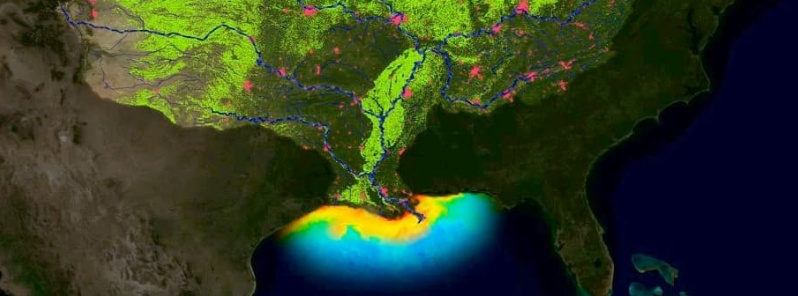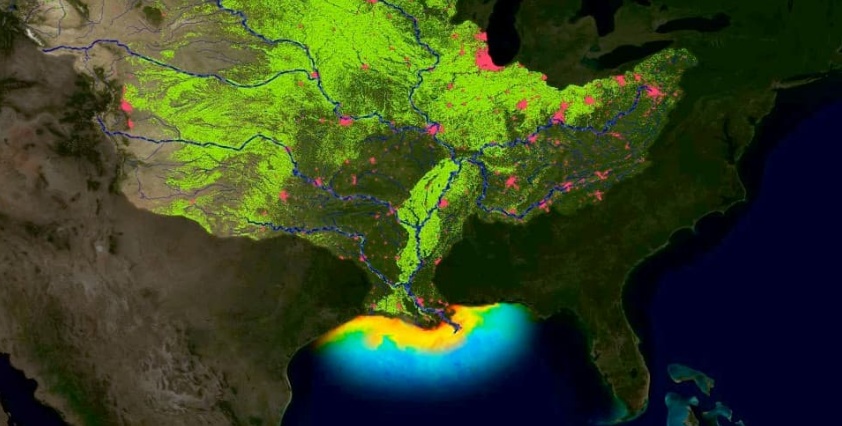Gulf of Mexico hypoxic ‘dead zone’ forecasted to exceed 17 250 square km (6 660 square miles)

The June 2018 forecast of the size of the hypoxic zone also known as the 'dead zone' in the northern Gulf of Mexico for late July 2018 is that it will cover 17 250 km2 (6,660 mi2) of the bottom of the continental shelf off Louisiana and Texas. The 95% confidence interval is that it will be between 14 628 and 19 727 km2 (5 648 and 7 617 mi2). While there are more than 500 dead zones around the world, the northern Gulf of Mexico dead zone is the second largest human-caused coastal hypoxic area in the world.
Hypoxia, or low oxygen, is an environmental phenomenon where the concentration of dissolved oxygen in the water column decreases to a level that can no longer support living aquatic organisms. Hypoxic areas, or 'Dead Zones,' have increased in duration and frequency across our planet’s oceans since first being noted in the 1970s. The largest hypoxic zone currently affecting the United States, and the second largest hypoxic zone worldwide, is the northern Gulf of Mexico adjacent to the Mississippi River.
The latest estimate is based on the assumption that there are no significant tropical storms occurring in the two weeks before the monitoring cruise, or during the cruise. If a storm does occur, then the size of the zone is predicted to be 70% of the predicted size without the storm, equivalent to 12 075 km2 (4 662 mi2). The predicted hypoxic area is slightly larger than the State of Connecticut (14 357 km2 / 5 543 mi2) and 4% larger than the average of 16 357 km2 (6 315 mi2)
Although this forecast has been the average size for the past 31 years, it is about three and a half times larger than the goal outlined by the Hypoxia Action Plan, which is about 4 998 km2 (1 930 mi2). Efforts to reduce the nitrate loading have not yet demonstrated success at the watershed scale.
Every year LSU Department of Oceanography & Coastal Sciences professors and Louisiana Universities Marine Consortium scientists Nancy Rabalais and Eugene Turner conduct a research cruise to measure the dead zone, which has little or no oxygen in the bottom waters. Turner and Rabalais then use these data in their computer models to predict its size in the summer.
Nutrients from the Mississippi River watershed, particularly nitrogen and phosphorus, fertilize the Gulf of Mexico's surface waters to create excessive amounts of algae. When the algae decomposes in the deepest parts of the ocean, it leads to oxygen distress and can even kill organisms in the Gulf of Mexico's richest waters. These low oxygen conditions threaten living resources including fish, shrimp and crabs, which humans depend upon for food and industry.

This image from a NOAA Environmental Visualization Lab animation shows how runoff from farms (green areas) and cities (red areas) drains into the Mississippi. This runoff contains an overabundance of nutrients from fertilizers, wastewater treatment plants, and other sources. This nutrient pollution eventually ends up in the Gulf of Mexico, leading to the formation of hypoxic "dead zones."
"This means that the impacts of water quality changes upstream in the Midwest affect our coast – directly," Rabalais said.
The dead zone occurs year-round, but it is most persistent and severe in spring and summer. Various computer models use the May nitrogen load of the Mississippi River as the main driving force to predict the size of this hypoxic zone in late July. If a storm occurs, then the size of the dead zone is predicted to be reduced to about 16 358 km2 (6 316 mi2).
Featured image: This image from a NOAA Environmental Visualization Lab animation shows how runoff from farms (green areas) and cities (red areas) drains into the Mississippi. This runoff contains an overabundance of nutrients from fertilizers, wastewater treatment plants, and other sources. This nutrient pollution eventually ends up in the Gulf of Mexico, leading to the formation of hypoxic "dead zones."

Quotation: «The June 2018 forecast of the size of the hypoxic zone also known as the ‘dead zone’ in the northern Gulf of Mexico for late July 2018 is that it will cover 17 250 km2 (6,660 mi2) of the bottom of the continental shelf off Louisiana and Texas. The 95% confidence interval is that it will be between 14 628 and 19 727 km2 (5 648 and 7 617 mi2). While there are more than 500 dead zones around the world, the northern Gulf of Mexico dead zone is the second largest human-caused coastal hypoxic area in the world».
I do not see any problems here. I will start the production of chilled and oxygen-enriched fresh water. I will replenish the Mississippi River and another fifteen rivers on the northern coast of the Gulf of Mexico on schedule: In the first year – 15%. In the second year – 20%. In the third year – 30%. And in the fourth – 35%. In four years I will completely destroy the dead zone – and squeeze it out into the ocean. Fisheries will be restored – in clean water the fish will come from the ocean, plus – the tourist business will be resumed on the whole coast.
Sincerely, developer of environmental programs, Victor Rodin. Ukraine. Khmelnitsky NPP. Tel. Kiev Star: 961336344. Mail: dorosydos@gmail.com.
— — —
Цитата: «В июне 2018 года прогноз размера гипоксической зоны, также известный как «мертвая зона» в северном Мексиканском заливе на конец июля 2018 года, состоит в том, что он будет охватывать 17 250 км2 (6 660 миль2) дна континентального шельфа от Луизианы и Техас. 95% доверительный интервал в том, что он будет между 14 628 и 19 727 км2 (5 648 и 7 617 миль2). Хотя во всем мире насчитывается более 500 мертвых зон, мертвая зона северного залива Мексика является второй по величине антропогенной прибрежной гипоксической зоной в мире».
Я здесь проблемы не вижу. Я начну производство охлаждённой и обогащённой кислородом пресной воды. Пополню реку Миссисипи и ещё полтора десятка рек на северном побережье Мексиканского залива по графику: В первый год – 15%. Во второй год – 20%. В третий год – 30%. И в четвёртый – 35%. Через четыре года я полностью разрушу мёртвую зону – и выдавлю её в океан. Будет восстановлен рыбный промысел – в чистую воду рыба придёт из океана, плюс – на всём побережье будет возобновлён туристический бизнес.